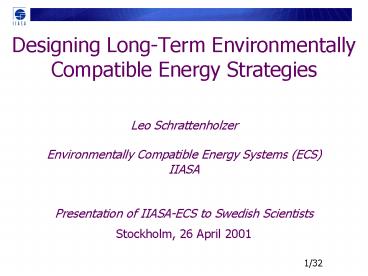Designing Long-Term Environmentally Compatible Energy Strategies - PowerPoint PPT Presentation
1 / 32
Title:
Designing Long-Term Environmentally Compatible Energy Strategies
Description:
Overall theme: Global energy and environmental interactions ... For each family one narrative storyline. ... The A1 Storyline. Summary ... – PowerPoint PPT presentation
Number of Views:14
Avg rating:3.0/5.0
Title: Designing Long-Term Environmentally Compatible Energy Strategies
1
Designing Long-Term Environmentally Compatible
Energy Strategies
Leo Schrattenholzer Environmentally Compatible
Energy Systems (ECS) IIASA
Presentation of IIASA-ECS to Swedish
Scientists Stockholm, 26 April 2001
2
Contents
- The ECS Project
- Technological learning
- Studying infrastructures
- Global E3 (energy-economy-environmental) scenarios
3
ECS Research Themes
- Overall theme Global energy and environmental
interactions - Technology assessment, learning curves, RD
effectiveness - Energy infrastructures
- Analysis of historical driving forces and
scenarios of future global environment-energy-econ
omy interactions - Integrated Assessment of climate change
- Collaboration with national and international
organizations and networks (IEW, EMF)
4
ECS Staff
5
Learning Curves
Cost ACap? ? Learning parameter 1-2?
Learning rate
6
Learning Rates, Numerical Values
7
42 Learning Rates of Energy Technologies
8
Two Learning Curves for Wind
9
Price Pattern for a New Product(IEA, 2000 and
Boston Consulting Group, 1968)
10
The Two-Factor Learning Curve
Cost ACap? RD? ? Learning-by-doing
parameter (Cumulative capacity) ?
Learning-by-searching parameter (Knowledge
stock) 1-2? Learning-by-doing rate (LDR) 1-2?
Learning-by-searching rate (LSR)
11
Two-Factor Learning Curves Input Data
Solar PV
Wind
12
Optimizing RD with ERIS
- Present ERIS based on version by Paul-Scherrer
Institute (PSI, Barreto and Kypreos) - Incorporating 2FLCs
- Minimizing total energy system cost
- Investment cost
- Operating and maintenance cost
- Fuel cost
- RD expenditures
13
RD Allocated to Wind in 2050 Different LSRs
14
Competing Learning Technologies
Changing WIN LDR
Changing WIN LSR
15
Infrastructures Research Questions
- What are the prospects for (international)
Eurasian energy infrastructures given (long-term)
supply and energy demand scenarios? - What are costs and benefits of new energy
infrastructures? - How effective and efficient are different
policies (e.g.subsidies, regulation, RD,
cooperation) for implementation?
16
Interregional Gas Trade Flows
17
Gas Trade by Pipe in Eurasia
18
Kaya Identity
CO2 Population (GDP per capita) (PE
Intensity) (Carbon Intensity) 1.7 1
2 -1
-0.3
19
GDP Per Capita Growth in Asia 1960-1997
20
Global Bioenergy Potential, High
21
IIASA-ECS Modeling Framework
22
IPCC SRES Reference Emission Scenarios
- Four scenario families (A1, A2, B1, B2)
- For each family one narrative storyline.
- 9 IIASA scenarios (out of a total of 40 scenarios
from 5 modeling groups). - Together, the IIASA scenarios cover the full
range of GHG and sulfur emissions found in the
literature.
23
The A1 StorylineSummary
Future world of (1) very rapid economic growth,
(2) global population that peaks mid-21st
century, and (3) rapid introduction of new and
more efficient technologies. Major underlying
themes are (4) economic and lifestyle convergence
and (5) capacity building, with (6) a substantial
reduction in regional differences in per capita
income. The three A1 scenarios describe
alternative directions of technological change in
the energy system fossil intensive (A1FI),
non-fossil energy sources (A1T), and a balance
across all sources (A1B).
24
IIASA SRES Scenario Indicators
25
Stabilizing Carbon Concentrations
26
Scenario Dependence of GHG Mitigation Costs
27
Sustainable-Development Scenarios A Working
Definition
- Basis development that meets the needs of the
present without compromising the ability of
future generations to meet their own needs
(Brundtland Commission, 1987). - Quantitative criteria
- Economic growth (GDP/capita) sustains throughout
the whole time horizon. - Economic inequity among regions is reduced
significantly over the 21st century. - reserves-to-production (R/P) ratios of
exhaustible primary energy carriers do not
decrease substantially - short- to medium-term environmental impacts
(e.g., acidification) are reduced and carbon
emissions at the end of the 21st century are
below todays levels
28
Global Economic Growth
29
Global Primary Energy
30
Carbon Intensity of Primary Energy
31
Reserve-to-Production Ratios
Reserve-to-production-ratio and global resource
consumption of natural gas and oil in
sustainable-development scenarios. Scenario
estimates for the year 2100 compared to values
for 1990. The long-term R/P ratio for the SD
scenarios either increases or stays near 1990
levels.
32
Conclusions
- Policy targets to promote Sustainable Development
- stabilization of population at or below median
levels - economic catch-up of the developing world
- increasing the productivity and efficiency of
energy use and conversion - promote zero-carbon energy sources
- non-decreasing R/P ratios































